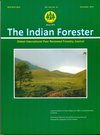Pollination in Aconitum heterophyllum Wall. - A Critically Endangered Temperate Himalayan Medicinal Plant Species
DOI:
https://doi.org/10.36808/if/2016/v142i12/108405Keywords:
Aconitum heterophyllum, Critically Endangered, Autogamy, Xenogamy, Geitonogamy, Pollination.Abstract
Aconitum heterophyllum Wall. is a critically endangered medicinal herb of temperate/alpine Himalaya and cultivation is recommended owing to its large demand in the herbal market for its sustainable utilization. Conserving its natural genetic pool is of immense importance for developing elite lines for cultivation. Pollination studies are important for assessing its breeding system as well as expected variation within a population. Present studies have revealed that Aconitum heterophyllum is mostly out crosser with modest possibility of geitonogamy, both of which require pollinator services and is mostly self-incompatible. No difference in pollination behaviour was observed between natural and domesticated conditions. Considering the obligate out crossing nature of the species, it is expected to encounter higher quantum of genetic variation in this species that can be useful for its genetic improvement.References
Brennan A.C., Harris S.A. and Hiscook S.J. (2003). The population genetics of sporophytic self -incompatibility in Senecio ssqualidus L. (Asteraceae): avoidance of mating constraints imposed by s-allele number. Biomed Sci., 358:1047-1050
Kaul M.K. (1997). Medicinal plants of Kashmir and Ladakh. Indus Publication, New Delhi.
Kuniyal C.P., Bhadula S.K. and Prasad P. (2003). Flowering, seed characteristics and germination behaviour in populations of threatened herb Aconitum heterophyllum Atrox. (Bruhl) Muk. (Ranunculaceae). Ind. J. Environ. Sci., 71: 29-36
Murugan R., Shivanna K.R. and Rao R.R. (2006). Pollination biology of Aristolochia tagata, a rare species of medicinal importance. Curr. Sci., 91:795-798.
Nautiyal B.P., Prakash V., Bahuguna R., Maithani U.C., Bisht H. and Nautiyal M.C. (2002). Population study of three aconites species in Garhwal for the monitoring of species rarity. Trop Eco., 43: 297-303
Nautiyal B.P, Nautiyal M.C., Khanduri P. and Rawat N. (2009). Floral Biology of Aconitum heterophyllum Wall. A critically endangered alpine medicinal plant of Himalaya, India. Turkish J. Botany, 33: 13-20
Raina R, Patil P, Sharma Y and Rana R. C. (2013). Reproductive biology of Swertia chirayita-a temperate critically endangered medicinal plant. Cytologia: Inter. J. Cytology, Cytosystematics and Cytogenetics, 66:1, 12-20
Singh D.K., Uniyal B.P. and Mathur R. (1999) Jammu & Kashmir. In: Floristic diversity and conservation strategies in India (Mudgal V, Hajra PK eds), II. Dehradun, pp 905–974
Stapf O. (1905). The Aconites of India – A Monograph. Bengal Secretariat Press, Calcutta.
Wafai B.A., Siddique M.A.A., Irshad A. Nawachoo Dar N.A., Bhat Amin and Mohi-Ud–Din G. G. (2005). Studies on reproductive biology of some endangered medicinal herbs as a prelude to their ex situ conservation. J. Ind. Bot. Soc., 84:88-106.
Downloads
Downloads
Published
How to Cite
Issue
Section
License
Unless otherwise stated, copyright or similar rights in all materials presented on the site, including graphical images, are owned by Indian Forester.





